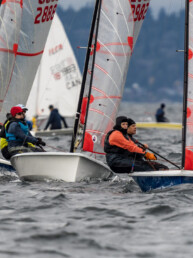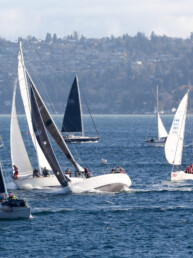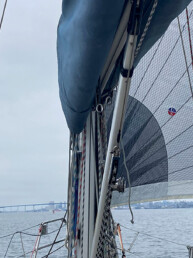Reviewing a fun, functional, and really fast new adventure-oriented powerboat.
“So, I just did the easiest 38.5 knots ever,” I texted a few friends.
If that doesn’t give you the hint that getting out on the new Arksen 30 is a different sort of boat test for me, I’m not sure what would. This is only the second non-sailboat test I’ve ever done for 48° North, but I’ve wanted to check out the Arksen 30 since I first laid eyes on it. The Arksen 30 is a sexy, speedy aluminum-hulled adventure boat with some very innovative features, including a fiberglass deck and cabin top for a blend of strength, relatively light weight, and durability. I just had to go for a ride.
But let’s back up. For the unfamiliar — as I was until a few months ago — Arksen is a UK-based designer of power yachts. The 30 is part of their “Adventure Series” and is built in Poland. The Arksen 30 is a versatile and fast powerboat with a wide range of potential uses. It boasts large fuel capacity accommodating a range of more than 200 miles at 30 knots of boat speed. It sleeps two in a V-berth and could be cruised by a small family for a short trip with the main cabin settee converted into a bed. The 30 comes with a number of elegant modern systems that make it remarkably easy to use, considering all of its power and speed potential.
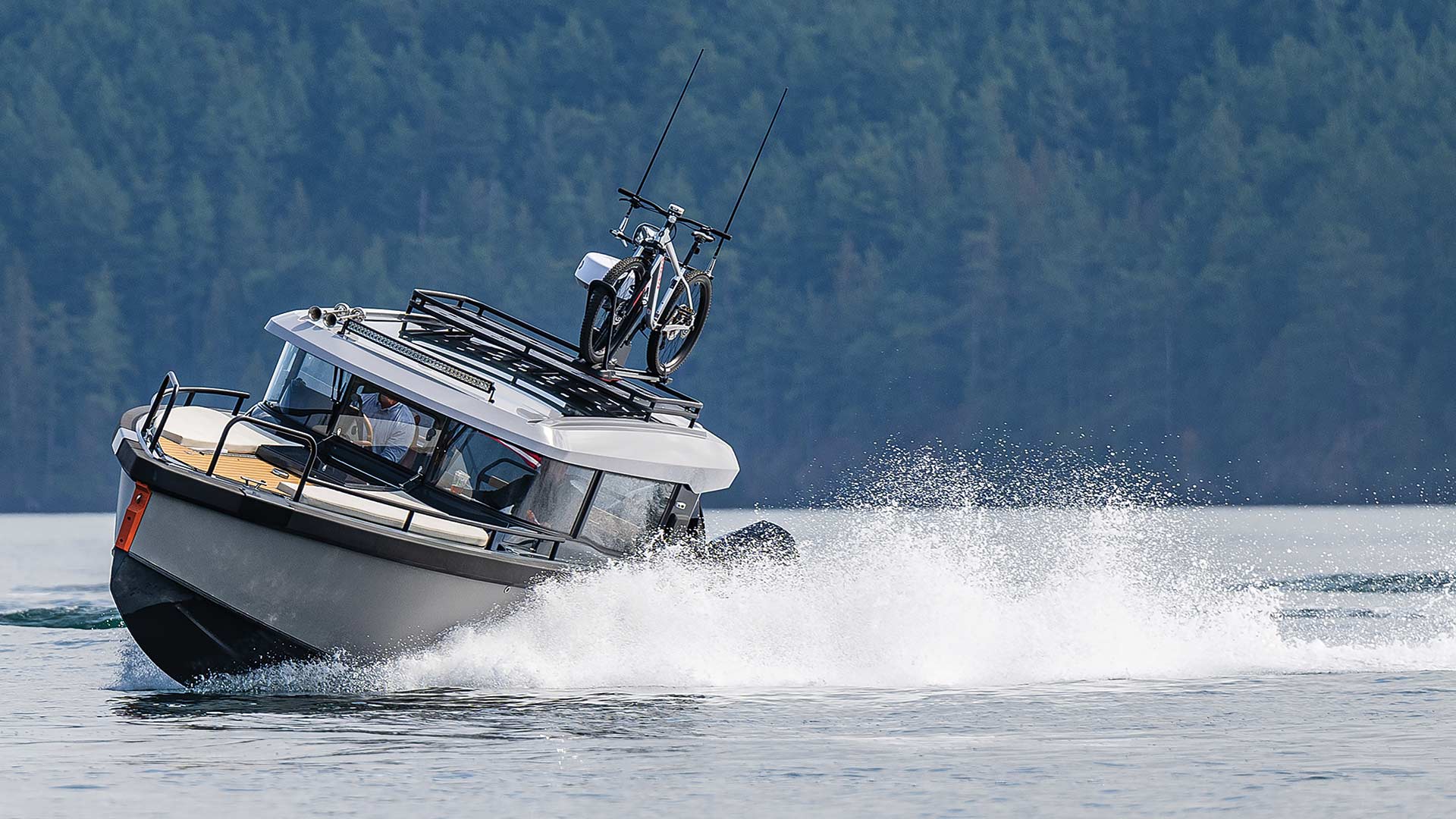
The Arksen 30’s hull is all form and function. The aluminum structure is shaped into a deep-V, prioritizing capability in nasty conditions over low-speed planing. Both its material and its design differentiate it from many competitors and assert its focus on the combination of durable comfort and readiness for whatever conditions Puget Sound or the straits farther north might send its way. The aluminum hull is 8 mm, which is thicker than many hulls of the same material. All up including the engines, the 31-foot-2-inch hull with an 8-foot-6-inch beam has a total weight around 7,500 lbs.
The deck and cabin top structure is fiberglass, dropped into the aluminum hull. The choice of material here provides some weight savings as well as acoustic insulation. The top deck comes standard with roof rack attachments that will fit anything you’d be able to put on top of your car; from bikes to kayaks to skis and snowboards, or a roof box or even a roof-top tent. The inclusion of this equipment as standard acknowledges that a boat with these design priorities needs some alternative storage options, but also suggests that the ideal Arksen 30 consumer might view the boat as a fun and fast way to travel to enjoy other adventurous outdoor activities. The other notable feature of the coachroof is the massive, opening sunroof.
Another unique design element of the hull is the closed-cell foam sponson found on either side. These are primarily intended to add a bit of user-friendly assurance when docking or to facilitate a quick fender-free pickup. Along with that, they actually come into play as part of the hull form in a tight turn, keeping the boat from rolling much beyond where they hit the water creating stability when cornering.
A lot of the Arksen’s real estate is devoted to an extremely cush interior main-salon/pilothouse. This is only a 30 foot boat, but it definitely makes the most of the space, with luxurious leather upholstery and quality finishes throughout. The main salon could make you believe you’re on a larger boat. I’d be as happy in there charging through a Pacific Northwest gale with the heater pumping as I would be relaxing with a glass of wine on a quiet summer evening. There’s a settee table to port paired with a small galley to starboard, each of which sit aft of the primary helm station and a convertible copilot seat, which hinges forward to seat four at the table. The hull’s deep-V helps accommodate standing headroom for me at 6-feet, while keeping the cabin’s profile neatly proportioned to the hull. The forward V-berth had more than enough room for me to lie down, but wasn’t quite tall enough to sit upright in bed at least with the sliding hatch above the berth closed. There’s a small head to port just aft of the V-berth, opposite a storage locker to starboard.
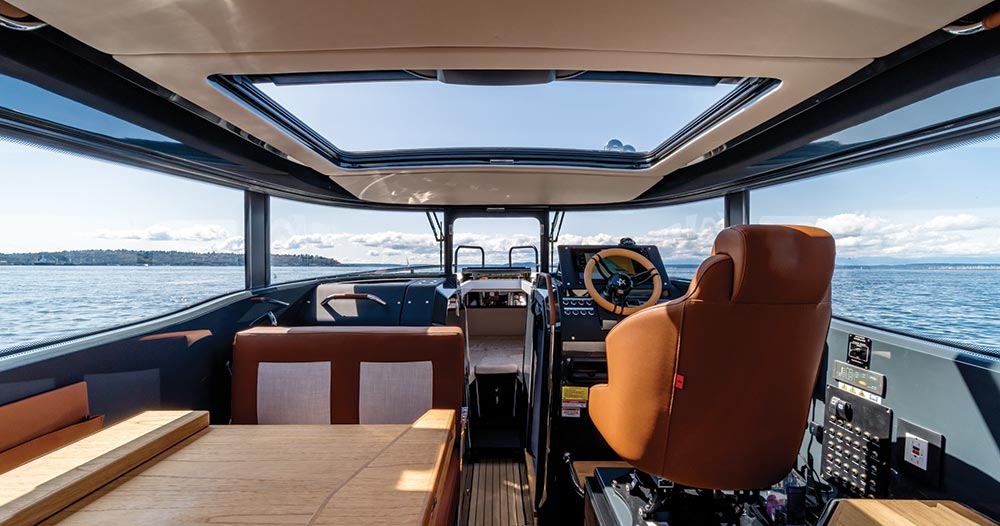
The width of the Arksen’s cabin utilizes most of the available beam, sacrificing side deck width, which I learned when I went forward in my standard fashion to remove a fender at the start of our test. Skirting along the side deck in socks while holding the roof rack, I was suddenly aware I had only about 5-inches of foothold. Yet, as with so many aspects of the Arksen 30’s design, there’s a thoughtful accommodation: the V-berth’s sliding hatch has a removable stair attachment that gives the easiest possible access to the bow, whether for lounging or to go up and do actual boat work.
The model of the Arksen 30 I got to test had a couple of upgrades that would improve my experience of ownership in a few key ways. Though it is available with a single engine, the pair of 250-hp Mercury outboards has the Arksen 30 positively swimming in power and speed. Perhaps more important (warning, sailboat guy discovering powerboat tech), the twin engines worked seamlessly with the JPO joystick option in a way that was staggeringly impressive. In spite of literally thousands of sailboat dockings in my life, I still manage to discover new ways to be anxious about (and often screw up) docking powerboats. In addition to the joystick, the Arksen 30 has a bow thruster, giving you even more easy to manage, slow-speed, fingertip control for tight-quarter maneuverability. The twin engines move independently to enable the joystick’s functionality. Though I’m certain I could develop skills to get by without the joystick system, I can’t overstate how confident it would make me if I had to take care of my brand new boat immediately.
The sunny October day on Puget Sound I had for my test was exactly the wrong weather to see the Arksen 30 shine. Well, it still shined big time, but it did so rolling smoothly over flat water. Taking the helm — and bouncing on the hinged shock-absorbing seat — I had great visibility at all times except the most banked turns, and found the seat so comfortable I’d almost be bummed I could get to my destination so quickly. With all of its power, the throttle felt well dampened, not like I was at risk of jolting anybody off the boat with an unintended goose on the gas.
As I mentioned previously, the Arksen 30 ran at a surprisingly comfortable 38.5 knots. The top speed potential increases to 45 knots with only one person, partially-full fuel tanks, and ideal conditions. Still, the boat felt much more settled at 25-30 knots, and owners will find significantly better fuel economy there anyway. I was quite impressed with the engines’ auto-trim system. I quickly got the read that the boat trim settings are critical to its ride quality, as well as the boat’s efficiency. In the flat water, the smoothest ride came from an orientation trimmed slightly bow-down. In waves, boat trim up would be the move — but that setting in flat water had us bouncing unnecessarily.
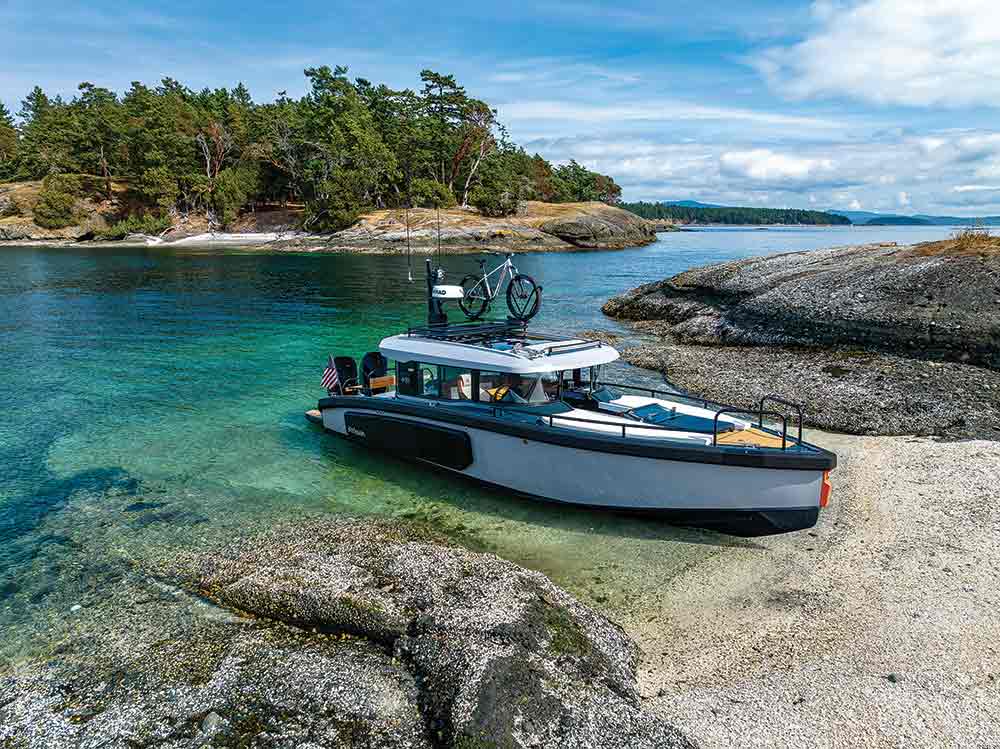
There’s just so much about the Arksen 30 that seems as cool as it is comfortable, and as functional as it is fast. It’s clearly not some big cruising hog, but otherwise there’s very little it can’t do. And for between $400,000-$475,000 (depending on options) it’s fair to say it should.
I haven’t even mentioned the aft deck, which would clearly be the spot to hang in the best weather, but what separates the Arksen 30 as an awesome boat for the Pacific Northwest is its capable comfort in burly conditions. With the heater on in the swanky cabin, there’s not a day or a patch of water when the boat wouldn’t be a good choice on the Salish Sea. The Arksen 30 didn’t take anything away from my love of sailing, but it did open my eyes to how much I might also like to say, “Want to cruise to Vancouver for lunch and be back in time for dinner at home?” Whether you want your boat to be the swankiest commuter on the planet, or your platform to go backcountry skiing, fishing, mountain biking, camping, surfing, or just zipping around for the fun of it – the Arksen 30 would be a terrific option.
Joe Cline is the Managing Editor of 48° North. Special thanks to Ben Oaksmith of Oaksmith Yachts for taking me out on the water.
Joe Cline
Joe Cline has been the Managing Editor of 48° North since 2014. From his career to his volunteer leadership in the marine industry, from racing sailboats large and small to his discovery of Pacific Northwest cruising —Joe is as sail-smitten as they come. Joe and his wife, Kaylin, have welcomed a couple of beautiful kiddos in the last few years, and he is enjoying fatherhood while still finding time to make a little music and even occasionally go sailing.


